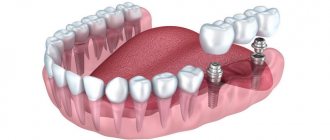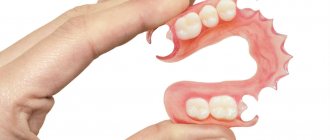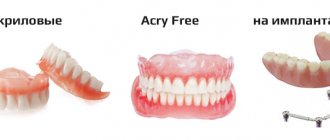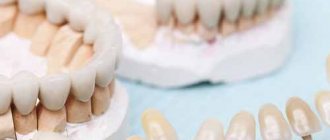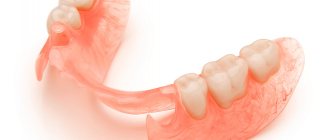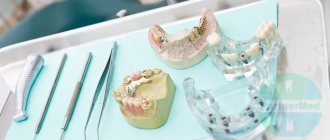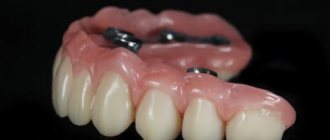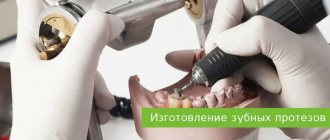A gold crown is a kind of “cover” that is placed on a seriously damaged tooth that is unable to perform its functions. This “cap” helps a person chew food comfortably again without experiencing discomfort or pain. The prosthesis can be made either for one damaged tooth or in the form of a bridge that fills the empty space in place of several missing teeth.
Crowns are made from high-grade gold - 900 gold standard. It is this high-quality metal that is best suited for making a dental “cap”, because it does not oxidize from contact with moisture and is hypoallergenic. At the same time, gold is a fairly durable material that can withstand heavy loads when chewing hard food.
Do you need a pin for a crown?
If the doctor insists on prosthetics, this already means that the tooth has undergone significant destruction. The crown helps restore the chewing function of the damaged unit and the aesthetics of the smile, this is especially true for the frontal region. Obviously, the prosthesis must have the necessary support. If there is a sufficient amount of natural tissue, the crown is placed directly on the tooth. In other cases, pins and stump inlays come to the rescue.
- Tooth decay of more than 30% is a good reason for installing a pin and crown.
- A chip of one of the walls of a tooth by 50% or more or a fracture at the root are indications for installing a core inlay and crown.
The technology also has limitations. A pin cannot be placed if there is untreated pulpitis, periodontitis and their complications (cyst, gumboil, etc.). Treatment will have to be abandoned if there are abnormalities in the structure of the tooth roots (too much curvature or thin walls). In some situations, the doctor is unable to unfill the canals after previous endodontic treatment, which also affects the possibility of installing a pin.
Dental crowns: criteria for choosing the best option for prosthetics
When choosing the best crown to restore a tooth, the following criteria will definitely be taken into account:
- The degree of tooth decay;
- The area of the dental unit that needs to be restored;
- The patient's wishes regarding the aesthetics of the result.
The location of the tooth that needs to be restored with a crown is a very important criterion when selecting it, because our teeth - the front and chewing ones - are subject to different loads. The chewing teeth are regularly subjected to a heavy load every time we eat something, and therefore the crown installed on the back chewing tooth must be strong and resistant to mechanical stress.
IMPORTANT: If your chewing tooth is severely damaged - more than 50%, it needs to be restored with a crown. Large fillings do not hold well, they can fall out or, even worse, break off along with part of the tooth. If the tooth splits in half or the root is damaged, the tooth will have to be removed and then implanted. Therefore, for damaged teeth, the best restoration option is to install a crown, not a filling!
But strength alone is not enough: a crown for a chewing tooth should help restore all the functions of a lost/damaged tooth, ensure proper distribution of the chewing load and have the longest possible useful life.
Taking into account all these requirements, the material for making a crown for a chewing tooth is selected. For prosthetics of back teeth, the following types of crowns are most often used: metal, metal-ceramics, zirconium. Which crown will be the best? To understand this issue, you need to study the characteristics, pros and cons of different types of crowns.
Inlay or pin: which is better?
The choice of support element depends on the specific clinical case. Both the pin and the core tab perform similar functions. However, each solution has its own advantages and disadvantages.
| Crowns on pins | Crowns on core inlays |
|
|
The stump tab is considered a more reliable option for chewing teeth and if it is necessary to install bridges. It is important to understand that this significantly increases the cost of treatment (the price per tab can reach up to 10,000 rubles). In addition, the manufacture of a stump insert requires an additional laboratory stage and appropriate manipulations.
Placing a crown on a pin can be recommended if the tooth does not have serious damage and there is no risk of pin breakage and root canal injury under the influence of chewing load. However, not all pins are suitable for the restoration of anterior teeth, especially if metal-free crowns are used. The crown and post on the front tooth should not contain metal if you want good aesthetics.
When installing a ceramic crown on a front tooth, the core inlay should also be made of ceramic.
How long do they last?
Dental “caps” made of gold are among the most durable dentures - subject to manufacturing technology and proper cleaning of the oral cavity, they can maintain their quality for 12-15 years. But even this period is a minimum, because in most cases gold does not change its appearance and shape even after 20-25 years.
Despite the fact that a crown made of precious metal is durable and can last a very long time, in some cases the doctor may recommend another way to eliminate the problem in the oral cavity. To ensure that prosthetics bring the most effective results, listen to the dentist’s recommendations.
Filling on a pin or crown: which is better?
This question interests many patients, and the answer is obvious. From the point of view of strength and reliability, the best option would be to install a pin and a crown. It is better to place a pin in a tooth under a crown in cases where the tooth is significantly damaged, especially when it comes to molars. A pin with a filling is installed for less significant damage and most often on the front teeth. This method also has its advantages. Firstly, this is a much cheaper technique. Secondly, all treatment takes place in one visit. The patient quickly returns to normal life and forgets about his problem. However, a filling with a pin gives a less reliable and predictable result.
Stages of installing a crown on a pin
- Initial consultation, determination of indications and contraindications for treatment.
- Preparation of tooth tissues and depulpation of root canals.
- Installation of the pin.
- Taking impressions or 3D modeling. Sending the results to the laboratory to make a permanent crown. Immediately after the procedure, the patient is offered a temporary crown.
- Trying on the finished product and fixing the crown with a pin.
Crown creation technology
To make a suitable prosthesis, the dentist first prepares the teeth - filing and grinding away excess enamel, and then taking an impression of the entire jaw. Casts of the upper and lower dentition become the basis for the production of an accurate plaster model of the client's jaw, which is made in a special laboratory.
Based on the copy, a trial “cap” of wax is created - it is intended to be tried on and, if necessary, to make changes. After fitting and corrections are made to the wax prototype mold, a solid gold crown is made in the laboratory. The surface of the gold dental “case” is ground and polished to get rid of sharp corners that can damage the soft tissues of the oral cavity, and only after that the product is sent to dentistry for subsequent installation.
Service life and design reliability
The service life of a crown on a tooth on a pin is quite decent if the treatment was carried out efficiently, and the patient avoided injury and followed the doctor’s recommendations. Even a classic metal-ceramic crown with a simple anchor pin costs on average 7–8 years. A more expensive ceramic crown on a fiberglass post will last even longer.
If during use the crown begins to wobble, then this is a bad sign, regardless of whether it is with a pin or without a pin. In this case, you need to consult a doctor as soon as possible. If the crown and pin fall out completely, this may be due to improper treatment, pathological processes in the root canals, or a banal injury. Repeated treatment in most cases is no longer possible.
How crowns are inserted
Installing dentures is a very painstaking job, because the “cap” should not make you feel discomfort. To get crowns inserted, you will need to visit the dentist several times.
- First visit. During the first visit, the dentist examines the oral cavity for diseases and, if necessary, treats caries or reinstalls worn fillings. If there are no serious problems in the oral cavity that require long-term treatment, the doctor prepares for prosthetics - removes excess enamel and grinds down the tooth, removing up to 1 mm of tissue. Next, he takes impressions of the jaw and creates a plastic onlay that will protect the ground down tooth from damage until a crown is made in the laboratory for permanent use.
- Second visit. After some time, the dentist will invite you to try on a wax prototype of the future gold crown and make adjustments to its shape.
- Third visit. When you visit the dentist for the third time, the doctor will install a ready-made gold “cap” in your mouth, but with a temporary fixation. During this period, the product can be easily removed and adjustments made to its shape if any problems arise.
- Fourth visit. This visit is usually the last in the process of installing gold dentures. 3 months after the third visit, you will need to visit the dentist again to remove the crowns and remove any remaining cement that temporarily attaches the “case” to the jaw. If the prosthesis does not cause discomfort, inflammation or other negative reactions of the body, the doctor firmly attaches it for permanent use.
How much does it cost to put a crown on a post?
The price of the finished solution directly depends on the materials of the pin and crown. The cost of a regular anchor pin is 500 rubles, but for a fiberglass one you will have to pay more than 1000 rubles. But these figures pale in comparison with the range of prices for crowns. If ordinary metal-ceramics costs 6–8 thousand, then products made of ceramics and zirconium will cost three times more. All preparatory manipulations will need to be added to the final amount.
An E-Max ceramic crown on a fiberglass pin, together with all stages of treatment, can cost 30,000 rubles and even more if we are talking about a VIP-class clinic. You can also choose a budget option with a metal-ceramic crown and an anchor or titanium pin. This solution will cost from 12,000 rubles, but is not suitable in all cases.
How much does it cost to insert a front tooth?
When making prosthetics for incisors and canines located in the smile line, you should choose those prostheses that differ least from neighboring healthy teeth in color and light reflectivity. Most often, prosthetists advise installing the following structures:
Metal-ceramic crown on an implant. This design is the highest quality and most reliable. But after its installation, a visual defect may appear: a part of the implant embedded in the gum may be visible. Prices for implants start from approximately 15 thousand rubles. and may vary depending on the type of metal used.- Ceramic crown on an implant. It looks better, but also costs more - from about 25,000 rubles per unit.
